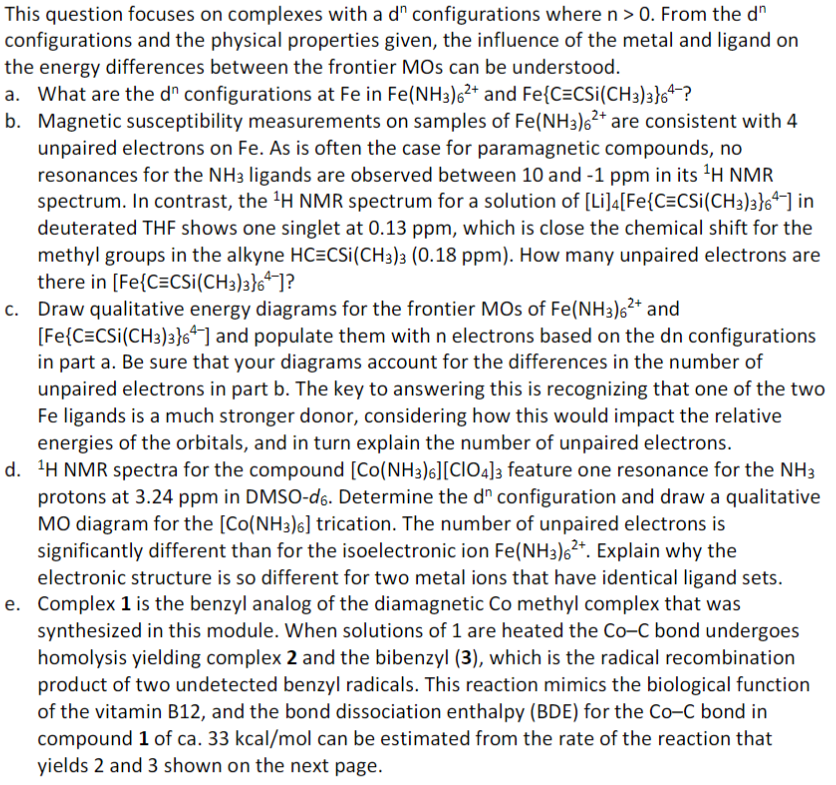
This question focuses on complexes with a d" configurations where n > 0. From the d" configurations and the physical properties given, the influence of the metal and ligand on the energy differences between the frontier MOs can be understood. a. What are the da configurations at Fe in Fe(NH3)62+ and Fe{C=CSI(CH3)3}64-? b. Magnetic susceptibility measurements on samples of Fe(NH3)62+ are consistent with 4 unpaired electrons on Fe. As is often the case for paramagnetic compounds, no resonances for the NH3 ligands are observed between 10 and -1 ppm in its ?H NMR spectrum. In contrast, the 1H NMR spectrum for a solution of [Li]4[Fe{C=CSI(CH3)3}64-) in deuterated THF shows one singlet at 0.13 ppm, which is close the chemical shift for the methyl groups in the alkyne HCECSI(CH3)3 (0.18 ppm). How many unpaired electrons are there in [Fe{C=CSI(CH3)3}64-)? C. Draw qualitative energy diagrams for the frontier MOs of Fe(NH3)62+ and [Fe{C=CSI(CH3)3}64-) and populate them with n electrons based on the dn configurations in part a. Be sure that your diagrams account for the differences in the number of unpaired electrons in part b. The key to answering this is recognizing that one of the two Fe ligands is a much stronger donor, considering how this would impact the relative energies of the orbitals, and in turn explain the number of unpaired electrons. d. 1H NMR spectra for the compound (Co(NH3)6][ClO4]3 feature one resonance for the NH3 protons at 3.24 ppm in DMSO-do. Determine the da configuration and draw a qualitative MO diagram for the [Co(NH3).] trication. The number of unpaired electrons is significantly different than for the isoelectronic ion Fe(NH3)62+. Explain why the electronic structure is so different for two metal ions that have identical ligand sets. e. Complex 1 is the benzyl analog of the diamagnetic Co methyl complex that was synthesized in this module. When solutions of 1 are heated the Co-C bond undergoes homolysis yielding complex 2 and the bibenzyl (3), which is the radical recombination product of two undetected benzyl radicals. This reaction mimics the biological function of the vitamin B12, and the bond dissociation enthalpy (BDE) for the Co-C bond in compound 1 of ca. 33 kcal/mol can be estimated from the rate of the reaction that yields 2 and 3 shown on the next page. This question focuses on complexes with a d" configurations where n > 0. From the d" configurations and the physical properties given, the influence of the metal and ligand on the energy differences between the frontier MOs can be understood. a. What are the da configurations at Fe in Fe(NH3)62+ and Fe{C=CSI(CH3)3}64-? b. Magnetic susceptibility measurements on samples of Fe(NH3)62+ are consistent with 4 unpaired electrons on Fe. As is often the case for paramagnetic compounds, no resonances for the NH3 ligands are observed between 10 and -1 ppm in its ?H NMR spectrum. In contrast, the 1H NMR spectrum for a solution of [Li]4[Fe{C=CSI(CH3)3}64-) in deuterated THF shows one singlet at 0.13 ppm, which is close the chemical shift for the methyl groups in the alkyne HCECSI(CH3)3 (0.18 ppm). How many unpaired electrons are there in [Fe{C=CSI(CH3)3}64-)? C. Draw qualitative energy diagrams for the frontier MOs of Fe(NH3)62+ and [Fe{C=CSI(CH3)3}64-) and populate them with n electrons based on the dn configurations in part a. Be sure that your diagrams account for the differences in the number of unpaired electrons in part b. The key to answering this is recognizing that one of the two Fe ligands is a much stronger donor, considering how this would impact the relative energies of the orbitals, and in turn explain the number of unpaired electrons. d. 1H NMR spectra for the compound (Co(NH3)6][ClO4]3 feature one resonance for the NH3 protons at 3.24 ppm in DMSO-do. Determine the da configuration and draw a qualitative MO diagram for the [Co(NH3).] trication. The number of unpaired electrons is significantly different than for the isoelectronic ion Fe(NH3)62+. Explain why the electronic structure is so different for two metal ions that have identical ligand sets. e. Complex 1 is the benzyl analog of the diamagnetic Co methyl complex that was synthesized in this module. When solutions of 1 are heated the Co-C bond undergoes homolysis yielding complex 2 and the bibenzyl (3), which is the radical recombination product of two undetected benzyl radicals. This reaction mimics the biological function of the vitamin B12, and the bond dissociation enthalpy (BDE) for the Co-C bond in compound 1 of ca. 33 kcal/mol can be estimated from the rate of the reaction that yields 2 and 3 shown on the next page







